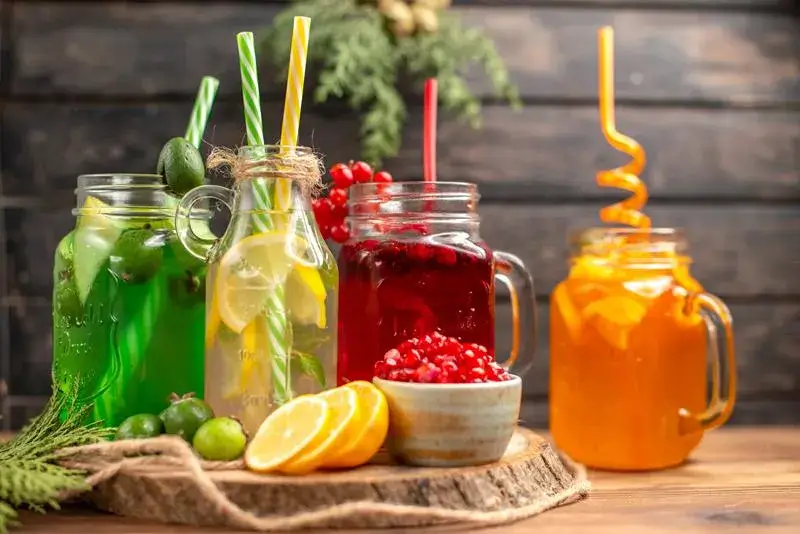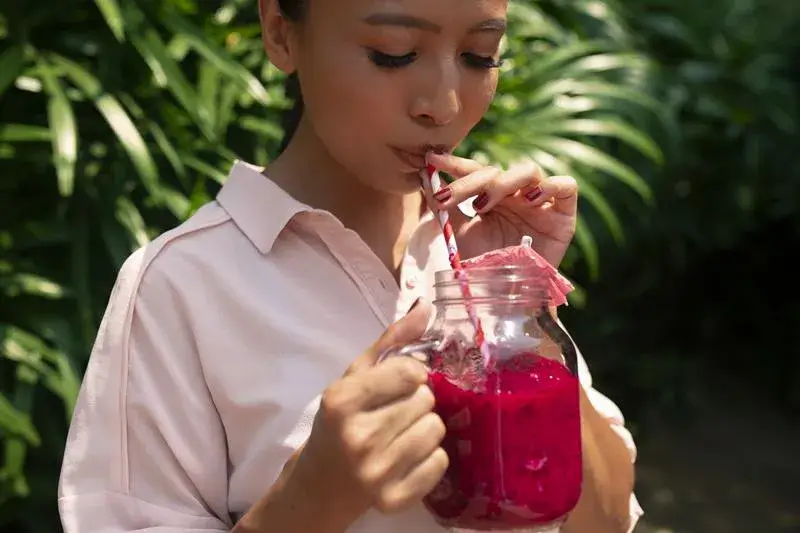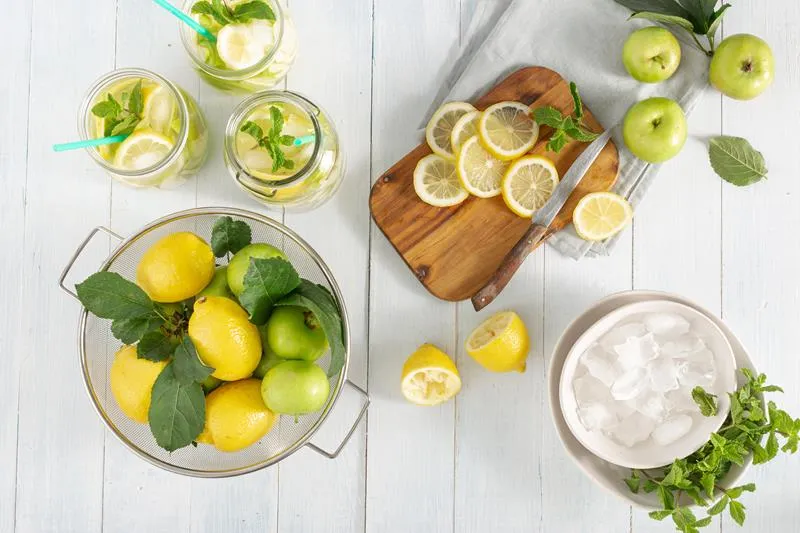Making fizzy, probiotic-rich drinks at home isn’t just a passing trend—it’s a creative, hands-on way to boost your gut health while sipping on something delicious. But each drink brings something different to the table. Let’s break down what sets them apart in flavor, fermentation, and feel-good benefits.
What’s the difference between these drinks?
Water kefir
It is made using kefir grains, which are full of helpful bacteria and yeasts.
Main microbes:
- Lactobacillus (supports digestion and the immune system);
- Bifidobacterium (keeps your gut healthy);
- Saccharomyces cerevisiae (helps with fermentation and bubbles).
These little microbes thrive in warmth (70–75°F / 21–24°C). Too chilly and they snooze, too hot and they give up. Keep them comfy for the best bubbles and benefits.
Kombucha
This drink is made using fermented tea and sugar, along with a special SCOBY (a mix of bacteria and yeasts).
Main microbes:
- Acetic acid bacteria (create taste and natural acids);
- Lactobacillus (adds more probiotic benefits);
- Zygosaccharomyces (helps make it fizzy).
Kombucha’s natural acids can be a bit much for sensitive tummies. Start slow with small sips—your gut will let you know when it’s good to go bigger.
Ginger Bug
This fizzy drink starts with just ginger, sugar, and water—fermented with the wild microbes naturally found on fresh ginger.
Main microbes:
- Lactobacillus fermentum (helps fight bad bacteria);
- Bacillus subtilis (helps digestion);
- Wild yeasts (create fizz and flavor).
Whether you’re sticking with one or exploring them all, it’s brewing time. Each probiotic brew offers its own taste, benefits, and friendly cultures—trust your body and savor the fun.
Craft your brew: a guide to the best ingredients
Good drinks begin with great ingredients. Since these brews thrive on live microbes, what you add really counts. Using fresh, top-notch ingredients boosts the flavor and helps those friendly bacteria and yeasts flourish:
- For Water Kefir, use simple sugars like white, cane, or coconut—they’re the best fuel for your grains. Avoid honey and fake sweeteners—they don’t cooperate. Also, chlorine in tap water can slow fermentation, so choose filtered or spring water.
- When brewing Kombucha, stick to plain black or green tea—flavored teas can confuse your SCOBY. Regular white sugar works best. If you add fruit later, fresh is key for that perfect zing and fizz.
- For a powerhouse Ginger Bug, use fresh, unpeeled ginger (just give it a good rinse). The skin’s got wild yeast that kickstarts the fermentation. Raw or brown sugar fuels it better than white, and filtered water keeps everything pure and happy.
One last tip: always use glass jars or bottles—metal or plastic can mess with the taste. Now you’re ready to brew something delicious.

Crafting your fermented fizz step-by-step
Probiotic fizzy drinks are healthy, refreshing and natural alternatives to soda. They’re loaded with probiotics, support gut health, and are great thirst quenchers. Here are some healthy recipes.
Water kefir – light, bubbly, and friendly for beginners
What you’ll need:
- 3–4 tablespoons of water kefir grains;
- 1/4 cup of sugar (white, cane, or coconut sugar works);
- 1 liter of filtered water;
- Optional: a slice of lemon or a few raisins (they help feed the grains).
How to make it:
- Dissolve sugar in warm water, then add cold water to make 1 liter.
- Pour into a clean glass jar.
- Add kefir grains.
- Cover with cloth and secure with a rubber band.
- Let ferment at room temp for 24–48 hours—longer means tangier. Open daily to release pressure.
- Strain out grains (reuse them!) and enjoy your drink.
To amp up the flavor and fizz, try a second fermentation after straining. Pour your kefir into a sealed bottle, add fruit (berries, mango, apple), ginger, citrus peel, or mint. Let it sit at room temp 1–2 days, then chill and enjoy.
Kombucha – a tangy, energizing brew
This is a fermented tea with a bright, slightly sour flavor that can be a refreshing tonic.
What you’ll need:
- 1 SCOBY (a living culture of bacteria and yeast);
- 1 cup sugar;
- 3–5 tea bags (black or green work well);
- 5 liters of water;
- 2 cups of starter tea.
How to make it:
- Boil water and steep tea bags for 10 minutes.
- Remove bags, stir in sugar until dissolved, then cool.
- Pour into a jar, add starter tea, and place SCOBY on top.
- Cover with cloth and ferment at room temp for 7–10 days.
- Taste from day 7—ready when balanced between sweet and sour.
Once your kombucha’s fermented, remove the SCOBY and pour the tea into bottles. Add fruit juice, fresh fruit, or herbs like ginger, lavender, or cinnamon. Seal and let sit at room temp for 2–3 days to carbonate.
Ginger bug – spicy, sweet, and naturally fizzy
This drink might seem unusual, but it’s a wild ferment made from ginger, sugar, and water. A spicy, homemade probiotic treat that’s full of zing.
You’ll need:
(to make the starter “the bug”)
- 2 tablespoons freshly grated ginger (no need to peel);
- 2 tablespoons sugar;
- 2 cups filtered water;
- A clean glass jar.
How to do it:
- Mix all ingredients in a jar.
- Cover with cloth and leave at room temperature.
- For 5–7 days, feed daily with 1 tbsp ginger and 1 tbsp sugar.
- When bubbles appear and it smells yeasty, it’s ready to enjoy.
The next step is to make soda out of it.
You’ll need:
- 1 liter of sweet tea, fruit juice, or honey water;
- 1/4 cup of strained Ginger Bug
How to do it:
- Pour your base liquid into a bottle.
- Add ¼ cup of ginger bug.
- Seal the bottle and let it sit at room temperature for 2–3 days to build fizz.
- Chill and enjoy your homemade soda
Flavor tips: Add juices (apple, grape, mango), herbs (basil, mint), or spices (cinnamon, clove). Use glass jars, avoid metal, store in the dark. If it smells bad, discard.
Stay safe while fermenting
Since this process relies on living microbes, following simple safety measures is essential for a tasty and healthy homemade brew.
- pH testing: Especially for kombucha (ideal: 2.5–3.5 pH). Mention test strips for beginners.
Mold signs: White fuzz = toss everything. Kahm yeast (wrinkly film) is harmless but should be skimmed.
- Alcohol content: Fermented drinks can have 0.5–2% ABV.
Whether you’re brewing Water Kefir, Kombucha, or Ginger Bug, you’re joining an age-old tradition blending science and tasty magic. Fermentation takes patience—some batches fizz just right, others surprise you. Trust your gut, tweak flavors, and embrace the bubbles. Now, raise a glass to your tiny microbial helpers and cheers to happy guts and fun experiments.
FAQ
Is it OK to drink probiotic drinks every day?
Why does SCOBY grow mold?
What to do if the Ginger Bug isn’t bubbling?
Feed it more sugar and ginger, keep it warm (around 70–80°F), and stir daily.
How to store water kefir grains long-term?
Rinse them, place in sugar water, and store in the fridge for up to 3 weeks, or freeze for longer.
Author


Alexandra Mukhina
Content writer on https://rythmoftheworld.com Experienced linguist and translator with a knack for crafting and refining diverse content. My goal is to produce engaging, informative texts that captivate readers. Passionate about reading, music, traveling, and exploring new avenues of personal growth.



